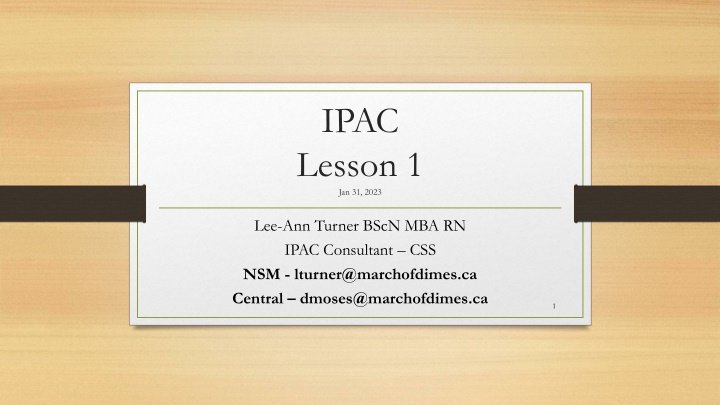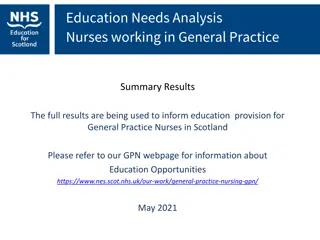
Evolution of Infection Control Practices Throughout History
Explore the historical timeline of infection control practices from as early as 1000 BC to significant advancements in the 1800s and beyond. Discover the evolution of personal cleanliness, isolation practices, food hygiene, diagnosis and treatment of infections, the role of hospitals, the impact of germ theory, hand hygiene practices, and more.
Download Presentation

Please find below an Image/Link to download the presentation.
The content on the website is provided AS IS for your information and personal use only. It may not be sold, licensed, or shared on other websites without obtaining consent from the author. If you encounter any issues during the download, it is possible that the publisher has removed the file from their server.
You are allowed to download the files provided on this website for personal or commercial use, subject to the condition that they are used lawfully. All files are the property of their respective owners.
The content on the website is provided AS IS for your information and personal use only. It may not be sold, licensed, or shared on other websites without obtaining consent from the author.
E N D
Presentation Transcript
IPAC Lesson 1 Jan 31, 2023 Lee-Ann Turner BScN MBA RN IPAC Consultant CSS NSM - lturner@marchofdimes.ca Central dmoses@marchofdimes.ca 1
1200-1500 Timekeeper Natalie Questions in chat please do Questions at end of segment all questions are important Come and go as your require Thanks to Gloria Natalie Dale Regional Learning Centre 2
Resources Public Health Ontario Local Public Health Units IPAC Canada (general and subscription) IPAC newsletter Day to day operational support Consultants and Hubs and IPAC leads Regional Learning Centre (IPAC and other great resources) For IPAC resources through the Regional Learning Centre simply click the link https://www.regionallearningcentre.ca/ipac 3
What will we cover? Lesson 1 Tuesday January 31 Topic: IPAC history, core competencies, occ health, chain of infection, hand hygiene, point of care risk assessment, PPE, organizational controls, safety in the workplace Lesson 2 Tuesday February 14 Topic: Environmental cleaning, environmental controls, congregate care settings, community day settings, mental health settings, hospice settings, child care settings, homelessness Lesson 3 Tuesday February 21 Topic: IPAC champion program, manuals, planning, education, trainers, audits Lesson 4 Tuesday February 28 Topic: IPAC audits, surveillance, train the trainer benefits, building an IPAC program Should you like to pass this on to staff so they can attend, please do so, and have them reach out to Gloria Froio at: gfroio@marchofdimes.ca 4
What will we cover? You will receive resources for each topic we cover IPAC history Core competencies Occupational health Chain of infection Hand hygiene Point of care risk assessment PPE Organizational controls Safety in the workplace 5
IPAC history 1000 BC - Early Infection Control Personal cleanliness Isolation practices Food hygiene Diagnosis and treatment of infections 500 BC - Early Hospitals Emphasis on space, use of prevailing winds Attendants distinguished for purity and cleanliness of habits Roman hospitals and high temperature sterilization 1800s Oliver Wendell Holmes: infection not miasma Semmelweis hand hygiene James Simpson wound disinfection and surgical asepsis Florence Nightingale hospital reform Andrew Smart germ theory and environmental (indirect) sources of infection Pasteur and Lister 6
IPAC history 1900s immunization, quarantine measures, soap, pasteurization, water treatment, sewers, boards of health, hospital asepsis The 20th century Group A Streptococcus as the model for cross infection and transmission The importance of airborne transmission move freely through the air, lighter than droplets The antibiotic era sulfonamides, penicillin TB sanatoria and screening for TB by x-ray (1940s) Outbreaks of MSSA infections 1930s onwards Gram negative hospital acquired infections 1950s Drug-resistant bacteria and hepatitis B by 1960s Hospital legionellosis and salmonella outbreaks 1970s Fungal superinfections and blood borne diseases 1980s Norovirus, influenza outbreaks, SARS, Ebola, MRSA, VRE, COVID-19 7
IPAC Core competencies are risk assessment chain of infection administrative controls - policy environmental controls - physical health provider controls movement, practice additional precautions contact, droplet, airborne occupational health and safety keep safe to keep your clients safe 8
Risk assessment Employer Care provider 9
Chain of infection the infectious agent which has the ability to cause disease. reservoir or source of infection can live and thrive. portal of exit from the reservoir. mode of transmission. portal of entry. susceptible host. 10
Hand hygiene Point of care risk assessment PPE 11
Organizational controls administrative controls environmental controls health provider controls 12
Questions? Comments? Next steps? Thank you for your time and interest! Thank you for coming to the session! 13
Safety in the workplace Hierarchy of Controls. Most effective to the least effective. Eliminating or substituting the hazard is the most effective control. Controls of the Environment and Administrative Controls are next, because these have already been put in place by your employer. Wearing Personal Protective Equipment is the least effective in the Hierarchy of Controls as this relies on your own judgment and knowledge about how and when to use it. 14






















